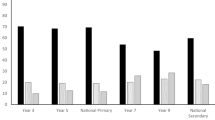Abstract
This paper deals with changes in Mexican higher education over the past 20 years, with particular reference to modifications in policy underway since the late 1980s. There is a general overview of the structure of the Mexican system and the basic changes that occurred during the expansionary period of the 1970s: unplanned growth in public universities which quickly became large, unwieldy organizations; the rapid expansion of the academic profession; heavy influence of politicization in public institutions, which diluted many of the traditional forms of academic organization; and an expansionist and undemanding government funding policy which was basically geared to giving access to growing student demand. The 1980s were a period of economic crisis which translated into restricted public funding for higher education and a government stance of benign neglect. However, during the past four years a new policy has been formulated which has channelled more funds toward the sector in a context of new demands: evaluation of institutional and individual performance, closer links with the productive sector, diversification of funding (mainly through higher student fees), and differential salary scales for academics among other things. The paper concludes with some remarks on emerging processes and various unresolved issues in a context where two rationales seem to be at odds within the system: the traditionalmodus operandi of institutions where assessment has always been lacking, and the new government policy which demands quality and accountability from higher education.
Resumen
Este ensayo brinda una visión de conjunto de los principales cambios producidos en la educación superior mexicana a lo largo de los uúltimos veinte años, con énfasis en las modificaciones más recientes en las políticas estatales aparecidas durante el gobierno de Salinas de Gortari. Se revisan las principales transformaciones de la expansión no regulada de los años setentas y posteriormente el período de ‘abandono benigno’ de la crisis de los ochenta. Se subrayan los principales aspectos de las políticas en curso: renovado impulso al financiamiento estatal en un contexto de evaluación institucional e individual, de insistencia en buscar vínculos entre instituciones y aparato productivo, de búsqueda de nuevas formas de financiamiento (especialmente el aumento de cuotas a estudiantes), y de escalas salariales diferenciadas de acuerdo con el desempeño académico. Termina el artículo señalando algunos de los procesos emergentes y algunas cuestiones críticas (‘issues’) no resueltas en un contexto de pugna entre la lógica tradicional de las instituciones universitarias no acostumbradas a evaluarse y a dar cuentas públicamente de su desempeño, y la nueva lógica de las políticas gubernamentales.
Similar content being viewed by others
References
Boyer, Ernest (1990).Scholarship Reconsidered: Priorities of the Professoriate, Princeton, N.J.: The Carnegie Foundation for the Advancement of Teaching. A short piece by Boyer summarizing the ideas in his book and written for theThe Times Higher Education Supplement (December 21, 1990) was translated into Spanish forUniversidad Futura, Mexico, 3(8–9), 1991.
Brunner, José Joaquín (1990). ‘Educación Superior en América Latina: Cambios y Desafíos’, Santiago de Chile: Fondo de Cultura Económica, 122–128.
Casillas, M., Gil, M. Grediaga, R., Pérez L. (1988). ‘Mitos y paradojas del trabajo académico’,Universidad Futura, Mexico, 1(1), 5–11.
Clark, Burton R. (1983).The Higher Education System: Academic Organization in Cross National Perspective, Berkeley: University of California Press, Chap. 6 [The Spanish language version is:El Sistema de Educación Superior: Una Visión Comparativa Internacional, Mexico: Nueva Imagen/Universidad Futura, 1992].
CONACYT. (1989).Indicadores: Actividades Científicas y Tecnológicas, México, 1991, 28.
Fuentes, Olac (1989). ‘La Educación superior en México y los escenarios de su desarrollo futuro’,Universidad Futura, Mexico, 1(3), 2–11.
Fuentes, Olac (1991). Las cuestiones críticas de la política de educación superior en la década de los 90’,Universidad Futura, 3 (8–9), 5–12.
Gago, H. Antonio (1980). 20 telegramas por la educación superior y una petición desesperada’,Universidad Futura, 1(1), 18.
Gago, H. Antonio (1992). ‘Testimony by the Under-Secretary for Higher Education before the Education Committee of the national Chamber of Deputies’, March 11, Mexico.
Kent, Rollin (1988). ‘En torno a mitos y paradojas del trabajo académico’,Universidad Futura, Mexico, 1(1), 12–17.
Kent, Rollin (1990). ‘Modernización Conservadora y Crisis Académica en la UNAM’. México: Editorial Nueva Imagen.
Kent, Rollin (1991). ‘Una política estatal para los académicos’,Universidad Futura, Mexico, 2(6–7), 22–29.
Kogan, Maurice (1987). “The Political View’ in Burton R. Clark (ed.),Perspectives on Higher Education: Eight Disciplinary and Comparative Views, Berkeley: University of California Press, 56–78.
Neave, Guy and Van Vught, Frans (eds.) (1991).Prometheus Bound: the Changing Relationship between Government and Higher Education in Western Europe, Oxford: Pergamon Press, ix-xv.
Author information
Authors and Affiliations
Rights and permissions
About this article
Cite this article
Kent, R. Higher education in Mexico: From unregulated expansion to evaluation. High Educ 25, 73–83 (1993). https://doi.org/10.1007/BF01384043
Issue Date:
DOI: https://doi.org/10.1007/BF01384043




